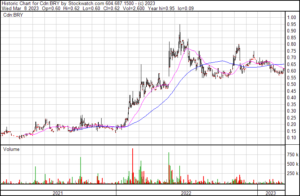Investing with a Margin of Safety
We all want to avoid loss, but at the same time we understand that reward requires risk.
This enduring challenge hangs over all of us to some degree, but if not approached properly, it can lead to indecisive investing strategies that lack a consistent and defensible approach. The result, not surprisingly, is underperformance, as many fall prey to the allure of fad investing or overly conservative approaches.
In fact, very few retail investors properly assess risk and reward and know how to identify what the industry calls a margin of safety.
What is a margin of safety?
In investing, a margin of safety may not be what you think it is.
It’s not a defensive stock or a safeguard to protect your investment. Rather, it’s thinking about potential and value. As Seth Klarman points out in his well-known book Margin of Safety, valuation is an imprecise art and thus requires a margin of safety to increase the chances of success.
Put plainly, valuation needs to be attractive, and this means there needs to be something compelling—not just the fact that XYZ blue chip stock is 10% off its recent highs and has strong revenue growth.
For us, margin of safety is a principle of investing in which an investor only purchases securities when their market price is significantly below their intrinsic value.
As an overly simplistic example, buying a large tech stock that trades at 20 times earnings with revenue growth of 50% provides less of a margin of safety than buying a smaller, more unknown tech stock that trades at 5 times earnings with 50% growth and is trading below its book value (more on that below). While the smaller company presents more risk than the larger company, it also presents the potential for more reward as it has a lot more room for growth.
It’s like buying Google right now. It may have solid growth numbers and be trading at a “discount,” but everyone knows it, and it’s not cheap by any metric. It could make you money, but the chances of providing incredible growth are low.
This, as you may have already guessed, is why the smallcap market is a great place to look for margin of safety. In fact, it becomes quite apparent the smaller you go. Just look through the many smallcaps we have covered over the last couple years, and you will see a clear trend of great companies trading below their intrinsic value.
The answer to this is simple: these companies are mispriced because they are too small to attract institutional or professional investors. They are invisible, and the result is a considerable mispricing of value.
How to spot it?
If you can identify smallcaps with a good margin of safety, you will be well ahead of the herd when the tide eventually turns. Think of it as a slingshot effect: an undervalued company with a micro market cap can quickly rocket.
There are several signs you can look out for. You can get technical and look into ratios like Price/Earnings to Growth (PEG), which takes into account the market price, earnings and future growth prospects.
This ratio helps show how larger companies may not have the same margin of safety as smaller companies, as their future growth prospects may not be as strong. Generally, if a company has a PEG of 1 or lower, it could represent good value. However, a PEG far below 1 can also mean the company is in trouble, so beware.
To keep it simple, just look at where a company is trading compared to its intrinsic value. In other words, check if it’s trading below book/cash value. This is called many things, but essentially when a company’s total share value is less than its cash minus debts, it is mispriced—literally trading “below cash” or below its intrinsic value.
Here’s a past example we shared with our subscribers:
Bri-Chem (TSX: BRY) which is a North American industry leader for wholesale distribution and blending of oilfield drilling, completion, stimulation and production chemical fluids. The Company sells, blends, packages and distributes a full range of drilling fluid products from 26 strategically located warehouses throughout Canada and the United States.
At that time, Bri-Chem was trading around $0.20, equating to a market capitalization of roughly $5.3M.
Bri-Chem’s business was generating :
- TTM revenues of $98.5M
- TTM Adj. EBITDA of $7.34M
- TTM net income of $9.3M
As for the balance sheet, Bri-Chem had:
- $30.5M in cash
- $5.9M in debt
- $71.7M in total assets$15.4M of working capital
- $22.6M on shareholders equity
At a $5.3M market cap, we felt the business had large margin of safety. While the industry Bri-Chem operates in is quite cyclical, and therefore not one to attract high multiples, we recognized the assets were irrationally mispriced. Given the total assets, the core business and the current valuation, we concluded there was a large enough margin of safety to substantially offset the risks of a owning a cyclical business.

Don’t forget your basic criteria
Of course, finding a company trading below its intrinsic value is just the first step. Once you find it, run it by your basic criteria to ensure it meets your investment strategy.
We have talked about ours at length in previous pieces, but as a reminder we look for the following:
- At least 25% year-over-year revenue growth per share
- At least two consecutive quarters of profit
- Low share count
- Solid insider ownership and a tight structure (illiquidity)
At the same time, there is a lot to be said for investing within your circle of competence.
Knowing an industry you’re thinking of investing in provides an advantage as you will understand the latest trends shaping the investment landscape.
Stick to a plan
While looking for a margin of safety is essentially looking for mispriced value, it can mean different things to different types of investors. We fall into the growth camp, as we look for stocks trading below book value or below 5 times earnings.
When it comes to thinking of margin of safety, it’s being able to say a stock is cheaper than it should be and thus the risk is worth it. You can find a large company growing quickly, but you will pay a premium because it’s known. Or, you can find the same growth rate for a smaller company, taking on more risk, but getting a better risk-reward scenario.
Ultimately, you want to be confident in your investment, preferably knowing the industry you are buying into and having a solid strategy behind you, based on established criteria.
As Warren Buffet said, “invest within your circle of competence, think like a business owner when buying equities, and buy at inexpensive prices to provide a margin of safety.”
